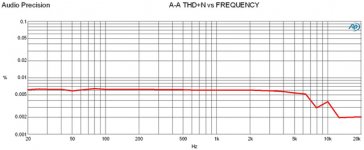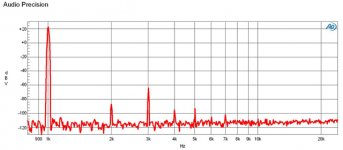Here is my latest amplifier module hot off the press!
The NXP180 Dual Die Lateral Amplifier Module.
It measures only 50mm x 50mm
Almost all of the components are SMD
It has very low Noise and Distortion as shown in the THD+N and FFT Graphs below.
The THD+N is flat from 5hz-20khz @ 0.006%
It is capable of power levels as high as 300 watts into 4 Ohms
and >200 watts into 8 Ohms.
All these measurements were done on a ATS-2 AP
Prototype module shown below.
The NXP180 Dual Die Lateral Amplifier Module.
It measures only 50mm x 50mm
Almost all of the components are SMD
It has very low Noise and Distortion as shown in the THD+N and FFT Graphs below.
The THD+N is flat from 5hz-20khz @ 0.006%
It is capable of power levels as high as 300 watts into 4 Ohms
and >200 watts into 8 Ohms.
All these measurements were done on a ATS-2 AP
Prototype module shown below.
Attachments
Hi Tinitus
Yes I hope so, They sound most excellent as well.
because of their small size and performance they are well suited to 5-7 channel amplifiers.
There are plans also to release a high powered SMPS based on a
new SMPS IC which uses a new type of switching technology that removes any remaining dissapation found in the output stage when using a conventional smps IC such as the SG3525 IC.
200 watts can be produced without any heatsinking at all and 400 watts with only a metal plate as a heatsink.
Higher powers at done using one of our own ICs which is based on the same technology.
The idea would be for DIY's to make a very small high quality multi channel amplifier using these modules and one of these smps at a very cheap price, which at the end of the day is at the heart of DIY audio.
Yes I hope so, They sound most excellent as well.
because of their small size and performance they are well suited to 5-7 channel amplifiers.
There are plans also to release a high powered SMPS based on a
new SMPS IC which uses a new type of switching technology that removes any remaining dissapation found in the output stage when using a conventional smps IC such as the SG3525 IC.
200 watts can be produced without any heatsinking at all and 400 watts with only a metal plate as a heatsink.
Higher powers at done using one of our own ICs which is based on the same technology.
The idea would be for DIY's to make a very small high quality multi channel amplifier using these modules and one of these smps at a very cheap price, which at the end of the day is at the heart of DIY audio.
Sorry but I'm completely confused. Why are all of you talking about SMPS (Switched Mode Power Supply, I presume) in the same breath as a linear analog amplifier circuit? And what ICs are you all referring to? I thought this amp has a conventional discrete OPS made of a pair of L-MOSFETs? 
Hi tcpip
The original project was to include a SMPS.
So that is why it was mentioned.
It was to use the FSFR2100 half-bridge resonant power switch from Fairchild.
This particular amplifier will not be released now in the advertised
form as the Dual Die mosfets that is uses are no longer available to me.
I have now redesigned the NXP180 to use 2SK1530 and 2SJ201
MOSFETs and it has been renamed the NXV200
More details on this change will be available on my web site by early next week.
The original project was to include a SMPS.
So that is why it was mentioned.
It was to use the FSFR2100 half-bridge resonant power switch from Fairchild.
This particular amplifier will not be released now in the advertised
form as the Dual Die mosfets that is uses are no longer available to me.
I have now redesigned the NXP180 to use 2SK1530 and 2SJ201
MOSFETs and it has been renamed the NXV200
More details on this change will be available on my web site by early next week.
Nice design no doubt but are you aware of that NXP is a semiconductor company?The Saint said:The NXP180 Dual Die Lateral Amplifier Module.
http://www.nxp.com
Tips: www.acronymfinder.com if you wonder if some letter combination might be unsuitable of some reason.
What does NXP stand for?
Next Experience (formerly Philips Semiconductors)
no abbreviation matches for NXV

What does NXP stand for?
Next Experience (formerly Philips Semiconductors)
no abbreviation matches for NXV


Ha Ha Ha.....
Thanks Peranders, I will be sure to check it out next time.
The NX series was originally stand for "Next Generation"
Because the AV series of amplifiers I did was the First Generation
Then came the NX series. Most of these were N-channel designs
with exception to the NX150 and a version of the NX400 with was called the NX400NP because that version had a N & P mosfets in the output stage.
and so came the NXP which really wasn't an acronym.
So much as it stood for next generation with an N&P output stage.
So NXV stands for Next Generation with VFET output stage
I hope that makes sense....
Thanks Peranders, I will be sure to check it out next time.
The NX series was originally stand for "Next Generation"
Because the AV series of amplifiers I did was the First Generation
Then came the NX series. Most of these were N-channel designs
with exception to the NX150 and a version of the NX400 with was called the NX400NP because that version had a N & P mosfets in the output stage.
and so came the NXP which really wasn't an acronym.
So much as it stood for next generation with an N&P output stage.
So NXV stands for Next Generation with VFET output stage
I hope that makes sense....
- Status
- This old topic is closed. If you want to reopen this topic, contact a moderator using the "Report Post" button.
- Home
- Vendor's Bazaar
- Ultra Small NXP180 Amp Module
![nx180-1_1[1].jpg](/community/data/attachments/89/89164-c5629d790acbf57ac5ab2bcd92d892f6.jpg)

